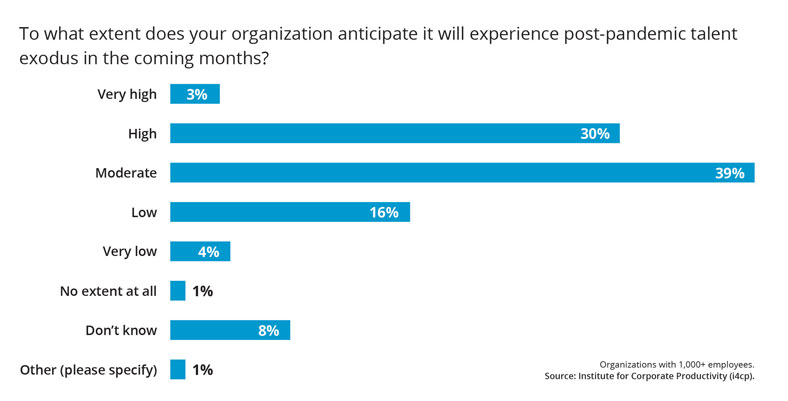Three Actions to Take Now to Counteract the Looming Talent Exodus

Most organizations—70% of those polled by the Institute for Corporate Productivity (i4cp)—anticipate a moderate-to-high talent exodus in the near future (the uncertainty of the Delta variant surge notwithstanding) as workers seek alternative job arrangements, new employers, or opt to leave the labor force entirely. While no employer has full control over what’s to come, there are several actions leaders can take to minimize attrition and gain a better understanding of their organization’s culture and employer brand.
Driving forces for the talent exodus (also referred to as The Great Resignation, The Turnover Tsunami, and The Great Talent Migration, among others) fall into two camps:
- Employee reaction to the crises and upheavals in everything from health and well-being, to social unrest, political divisiveness, and especially the changes in work experience occasioned by working remotely, specifically:
- Burnout (62%)
- The requirement to return to office (29%)
- Not offering flexible work options (27%)
- Employee disengagement due to the year of remote work (21%)
- The usual suspects for attrition, amplified by a great demand and low supply for talent:
- Lack of advancement opportunities (48%)
- Compensation (44%)
- Lack of development (26%)
- Dissatisfaction with work/projects (23%).
HR leaders know the cost of attrition is high—some estimate the costs from 100-200% of base and benefits—but it’s likely to be much higher when factoring in the ripple effects that occur when someone’s departure disrupts an effective team.
Here are three actions you can take to get ahead of the expected talent exodus:
1. Conduct an employer brand competitive assessment.
Do you know what current, former, and prospective employees are saying about your organization on social media? Now is the time to collect and analyze data on how attractive your brand is compared to key competitors or others in your industry. A weak or damaged brand won’t attract new talent and makes it more difficult to retain top performers.
For a quick snapshot, go to the Culture 500 website to view AI-based analysis of your employer brand and those of your competitors based on the “Big 9” cultural values. If your organization isn’t listed or you want to dig deeper, contact us for detailed analysis using MIT-developed technology.
2. Assess the health of your organization’s culture.
A positive organizational culture is the best defense against unwanted attrition. i4cp’s Culture Renovation® research identified the traits of a healthy culture—the cultural aspects that really make a difference. You can find the traits of a healthy, high-performance organization in Kevin Oakes’ best-seller Culture Renovation: 18 Leadership Activities to Build an Unshakeable Organization. Go to culturerenovation.com for dozens of free resources and culture assessment tools.
3. Start conducting stay interviews.
Only about 20% of organizations use stay interviews—about a quarter of the number that use exit interviews. Leaders should reverse this ratio, talking with employees—especially top talent—before they make the decision to leave is critical to retention.
In addition to the helpful stay interview tips we recommend in i4cp’s Stay Interview Questions and Prompts, now is the time to add questions to your stay conversations that relate to the talent exodus drivers of burnout, reaction to remote working requirements, desire for flexible work options, and disengagement caused by working remotely. Stay interviews are a good example of the adage “an ounce of prevention is worth a pound of cure.”
Use these resources to position your organization to thrive when the talent exodus gains speed; better to benefit from the trend than be the victim of it.






